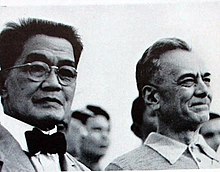Alternative Parties in the Philippines: National Socialist
The period traversing the years 1907 to 1941
featured our first experience of nationwide politics, with the country
having 13 elections in all. Although conducted under auspices of
American administration, it is without doubt that this period began
forming the Filipino statesmen (or politicians for that matter) whose
valuable service our nation still remembers until today. However, with
the many political parties these people brought forth during the period,
only the Nacionalista Party dominated the scene. Also, only the
Nacionalista Party survived from this era and is continuing to operate
until today. What were almost neglected in the mainstream political
history of our country during this period were the political parties
formed in opposition to the gargantuan Nacionalista, but failed to
survive to see America grant independence to her only colony in Asia.
With this in the fore, introducing these parties, their formation, their
members, platforms, successes, failures and their eventual dissolutions
are being aimed in this series.
 |
| Standard bearers of the National Socialist Party for the 1935 elections Emilio Aguinaldo and Raymundo Melliza Photo courtesy of Wikipedia |
***
See the fifth part of the Alternative parties series by clicking here.
National Socialist Party (1934-1935)
The National Socialist Party was established by Former President Emilio Aguinaldo in 1934. Like Aglipay's Republican Party, which had no clear evidence of direct relations with the U.S. Republican Party, Aguinaldo's National Socialist Party had no clear evidence of direct relations with Adolf Hitler's National Socialist (Nationalsozialismus) Party. This was in preparation of the 1935 presidential elections, with the intent to use the party to carry him in the campaign.
Aguinaldo announced his candidacy on June 2, 1935. He was the first of the candidates to proclaim bid for the presidency of the Commonwealth. Although, his presidential bid cost him the loss of support from the “Coalition of Oppressed Masses,” which was composed of the Republican Party, the Socialist Party, the Partido Komunista ng Pilipinas (PKP), and the Toilers’ League. The Sakdalista Party, which was then part of this coalition, had been smashed by this time after their failed uprising in May of 1935. In his acceptance speech at Cavite, delivered to an estimated 5,000 people, Aguinaldo laid out his Declaration of Purposes:
***
See the fifth part of the Alternative parties series by clicking here.
***
National Socialist Party (1934-1935)
 |
| Emilio Aguinaldo (left) and Gregorio Aglipay (right) Photo courtesy of Wikipedia |
Aguinaldo announced his candidacy on June 2, 1935. He was the first of the candidates to proclaim bid for the presidency of the Commonwealth. Although, his presidential bid cost him the loss of support from the “Coalition of Oppressed Masses,” which was composed of the Republican Party, the Socialist Party, the Partido Komunista ng Pilipinas (PKP), and the Toilers’ League. The Sakdalista Party, which was then part of this coalition, had been smashed by this time after their failed uprising in May of 1935. In his acceptance speech at Cavite, delivered to an estimated 5,000 people, Aguinaldo laid out his Declaration of Purposes:
1) Shortening of the transition period to three or five years
2) The revision of the constitutional provision for compulsory arbitration
3) An effective reorganization of the government branches to secure efficiency and simplification
4) A policy of strict economy, with its consequent reduction of expenditures and salaries
5) The salary of the president is to be slashed 50 percent
6) Revision of the present taxation system, and introduction of land taxation based on the land’s productivity and not on its value
7) A national lottery under government auspices
8) Increased concessions to labor, in the form of living quarters, opportunity for advancement, and low rents
9) Reformation of the present educational system with a view to making it vocational and nationalistic
10) The establishment of a system of national defense
11) The protection of basic agricultural products from adverse trade movements
His platform also included the following:
Emilio Aguinaldo and Manuel Quezon together on Flag Day, 1935 (Photo courtesy of Wikipedia)
 |
| Raymundo Melliza (Photo courtesy of Iloilo Blogazine) |
1) Establishment of an Unemployment Bureau to solve the unemployment problem of the Filipino working class
2) Creation of a National Board on sugar, copra, abaca, rice, and tobacco
With his promise for "early restoration of our Glorious Republic", Aguinaldo’s bid was supported by the Veteranos de la Revolucion (lit. Veterans of the Revolution). This association had experienced increasing numbers during the administration of Governor General Leonard Wood, with 20,000 joining in 1926 alone. Aguinaldo is the head of the Veteranos de la Revolucion. Among those that had also expressed their support to Aguinaldo’s bid were Sixto Lopez, Anastacio Teodoro, former Manila Mayor Justo Lukban, Emiliano Tria Tirona, Narciso Lapuz, Vicente Sotto, and Miguel Cornejo. Former Iloilo Governor Raymundo Melliza was chosen as his vice president. Aguinaldo garnered 17.54% out of more than 1.2 million votes cast nationwide. He was followed closely by Gregorio Aglipay, who had 14.47% of the vote. Manuel Quezon won a landslide victory with 67.99% of the vote. Aguinaldo then filed a complaint concerning electoral fraud, although he had pledged during the campaign to accept the electoral results. However, this came to naught for the Commonwealth was still inaugurated on November 15, 1935.
Want to continue this series? Read Part 7 of the Alternative parties series.
See the references by clicking here.
See the references by clicking here.






Comments
Post a Comment